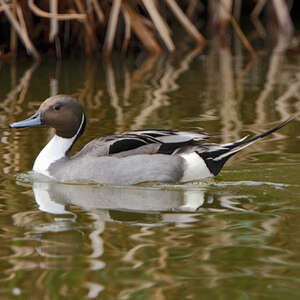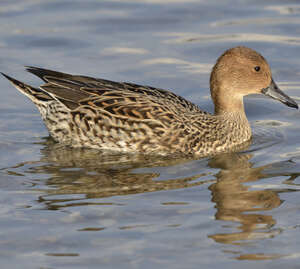Northern Pintail
Anas acuta - Canard pilet
Identification
The Northern Pintail is a sleek and elegant duck, finer and slimmer than the Mallard and this impression is accentuated by its long, tapered tail which earned it the scientific name acuta.
The adult male is unmistakable at first glance. Its chocolate-brown head is marked at the rear with a white line rising along the side of the neck. On the top of the body we notice especially the long, black scapulars edged with white falling on the flanks. They are followed by the long bicoloured tertials covering the back and the rump. The front of the neck, the chest and the abdomen are white. The flanks are finely mottled in grey. The hindquarters are distinctly bicoloured, white-cream and black with a clear vertical divide. The tail, long and pointed, is bicoloured, white with black strips. The beautiful emerald-green mirror of the secondaries is only visible in flight or during grooming. The bill is greyish blue with black on the culmen and the margin. The legs are grey.
The adult female, like the other duck females, has a discreet and cryptic brown plumage. We recognise her by her slim silhouette, reminded of the male, with long, thin neck and tail long and pointed, but to a lesser extent. The head clearly russet and the grey steel- coloured bill are good identification criteria. The rest of the plumage is all shades of browns, most feathers dark and bordered in light, giving the plumage a scaly appearance. Here too the scapulars are slightly lengthened. The mirror is not normally seen on the bird at rest.
The male in eclipse and the juvenile have female-type plumages, to the point that at the end of summer, it's not easy to recognise the age and sex of a Pintail.
Subspecific information monotypic species
Foreign names
- Canard pilet,
- Ánade rabudo norteño,
- arrabio-comum,
- Spießente,
- nyílfarkú réce,
- Pijlstaart,
- Codone,
- stjärtand,
- Stjertand,
- kačica ostrochvostá,
- ostralka štíhlá,
- Spidsand,
- jouhisorsa,
- Pylsterteend,
- ànec cuallarg,
- Grafönd,
- rożeniec (zwyczajny),
- garkaklis,
- dolgorepa raca,
- Шилохвость,
- Itik lancip,
- オナガガモ,
- 针尾鸭,
- เป็ดหางแหลม,
- 尖尾鴨〔針尾鴨〕,
Voice song and call
The male's courtship song consists of repeated tic or yuk warbles, accompanied by whistled uitchii calls that are nasal-sounding. The female responds with hurried quacks. The warbling syllables of the male are similar to those of the Winter Wren. Outside of breeding season, the species is silent.
Habitat
In its breeding range, the Northern Pintail frequents freshwater bodies of the interior, rich in vegetation and nutrient-rich, marshes, various water bodies and riverbanks. Along the way, it can also inhabit maritime shores. It winters in large numbers in the continent's rich vegetation in the south of the Northern Hemisphere.
Behaviour character trait
The Northern Pintail, like most members of its family, is a gregarious species. The only time individuals become isolated is during the breeding season.
This requires pairing and some territoriality. Outside of this period, it is rare to see pintails alone. It is also common to observe mixed species groups in stopover areas or in the winter season. Ducks are more than willing to mix with each other.Since the nesting area is located very far north, the pintail is a migratory species. The life of this species is thus marked by migrations between these northern areas and its southern wintering area. These movements are always done in groups.
While the male has a plumage that is made to be seen, the female has a discreet plumage, intended to camouflage it in the vegetation. She uses this to her advantage to remain unnoticed on the nest and thus minimize predation.
Flight
In flight, the long and slender neck, narrow wings with a mirror mark, and pointed tail are diagnostic. Its flight type is typically a waterfowl flight. The long and narrow wings are related to its long migratory distance.
Like most waterfowl, the Northern Pintail undergoes molting after the breeding season. It simultaneously moults all its remiges and is unable to fly for 3 or 4 weeks in summer.
Dietfeeding habits
The Northern Pintail is mostly vegetarian. Just like all surface ducks in aquatic environments, it dives. It feeds by tipping its body forward to search its food from the bottom of shallow waters. This consists of vegetation and their seeds. It can also forage on land. On the way, it also eats grains scavenged from the fields. It completes its diet with invertebrates, crustaceans, mollusks, insects, and worms.
Reproduction nesting
She begins in May. The mature birds, that have begun their nuptial parades in the migration stops, often arrive to the breeding sites already paired.
But if necessary, the parade continues in the breeding sites in small gestural and vocal groups.The Northern Pintail nests in wet meadows, in the marshy borders of ponds or slow-flowing rivers. The nest is built directly on the ground with some vegetal elements and is lined with the ventral down of the female. It is well hidden in the marsh vegetation. The laying is of 7-11 eggs that are incubated for 22-24 days. The chicks are nidifugous and it is the female who takes care of the brood, without the help of the male. The flight begins after 40 days but it still takes 50 more for the chicks to reach emancipation.
Geographic range
The Northern Pintail is a holarctic species, nesting in the high latitudes of the North American and Eurasian continents. It occupies a continuous continental band, interrupted only by the sea (Bering Strait and Atlantic Ocean), with its southern limit passing through the north of the United States, the Baltic Countries, Mongolia and extreme southeast Russia. Its wintering area is disjoint. It mainly concerns the south of the U.S., Central America, the North Sea, the Mediterranean Basin, North Africa and the Sahel region, with a peak as far east as the Great Lakes region, the south of the Caspian Sea and Southeast Asia.
Threats - protection
IUCN conservation status
concern
in the Wild
threatened
evaluated
Even though the recurrent droughts in the Sahel region affects the population of the western palearctic, which is declining due to it's global distribution, the Northern Pintail is still one of the most numerous species of ducks and therefore not threatened.
Sources of information
- IOC World Bird List (v15.1), Gill, F and D Donsker (Eds). 2025-12-07.
- Le guide ornitho : Le guide le plus complet des oiseaux d'Europe, d'Afrique du Nord et du Moyen-Orient : 900 espèces, Svensson, Mullarney, Zetterstrom
- Wildfowl: An identification guide to the ducks geese and swans of the world, Madge, S and Burn, H
- Les palmipèdes d'Europe, Géroudet P., MAJ M. Cuisin
- HBW Alive,
- Avibase, Lepage Denis
- xeno-canto, Sharing bird sounds from around the world,
Other sources of interest
 Specification sheet created on
23/07/2023 by Jean François
Specification sheet created on
23/07/2023 by Jean FrançoisTranslation by AI Oiseaux.net
© 1996-2026 Oiseaux.net
- Accipitriformes
- Aegotheliformes
- Anseriformes
- Apodiformes
- Apterygiformes
- Bucerotiformes
- Caprimulgiformes
- Cariamiformes
- Casuariiformes
- Charadriiformes
- Ciconiiformes
- Coliiformes
- Columbiformes
- Coraciiformes
- Cuculiformes
- Eurypygiformes
- Falconiformes
- Galliformes
- Gaviiformes
- Gruiformes
- Leptosomiformes
- Mesitornithiformes
- Musophagiformes
- Nyctibiiformes
- Opisthocomiformes
- Otidiformes
- Passeriformes
- Pelecaniformes
- Phaethontiformes
- Phoenicopteriformes
- Piciformes
- Podargiformes
- Podicipediformes
- Procellariiformes
- Psittaciformes
- Pterocliformes
- Rheiformes
- Sphenisciformes
- Steatornithiformes
- Strigiformes
- Struthioniformes
- Suliformes
- Tinamiformes
- Trogoniformes
































